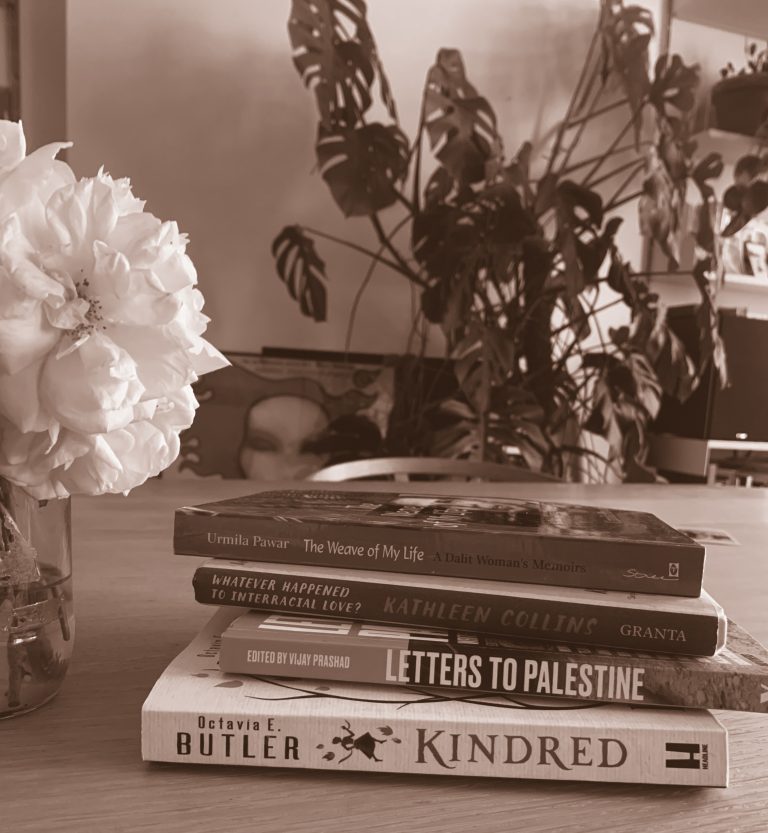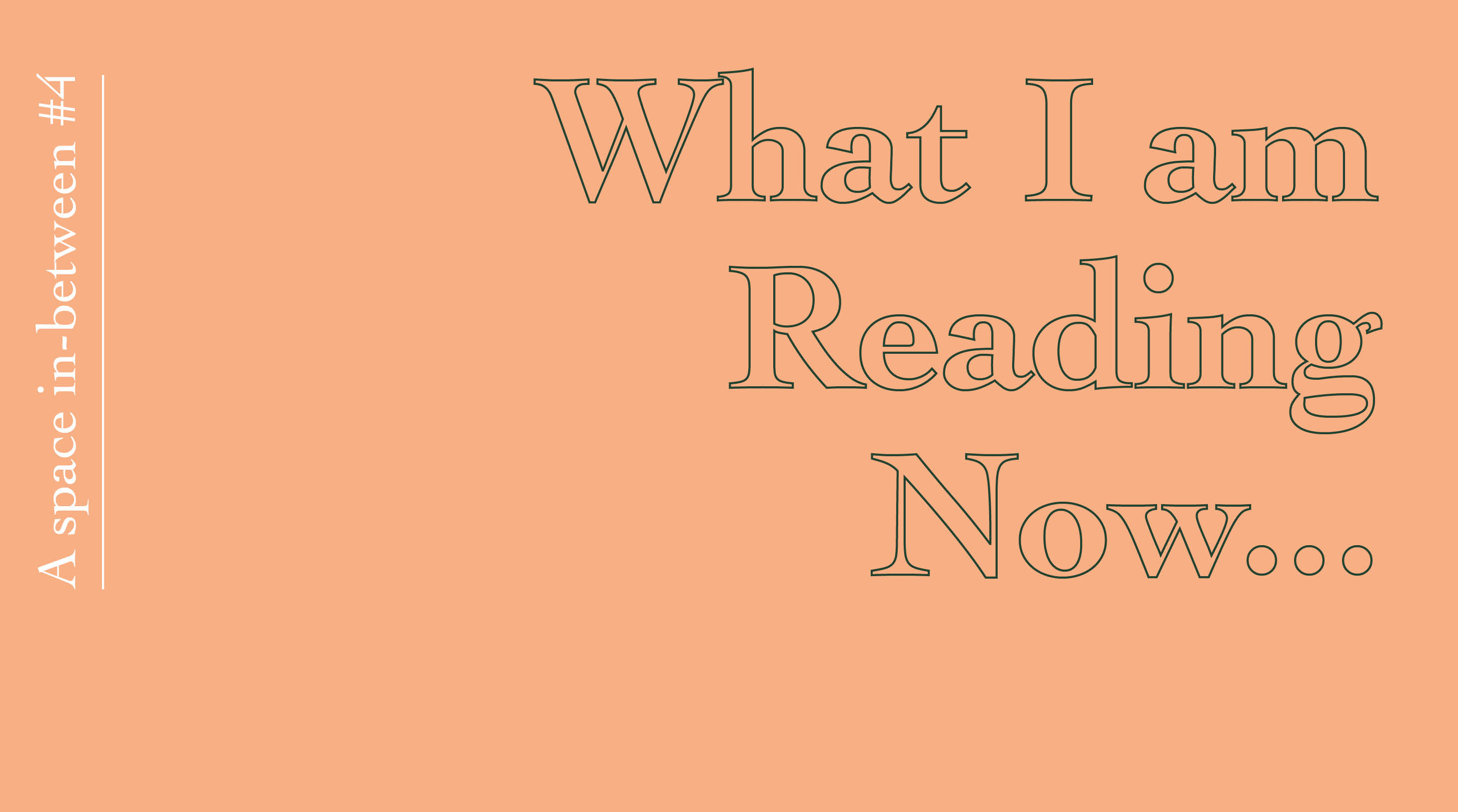What I am Reading Now…
Jemma Desai
July 2021
I am thinking a lot about the violence of cognitive dissonance. As a writer I have often been humbled (and sometimes wounded) by the ways the same words read by two different people elicit such viscerally (in)different responses, sometimes considerably removed from what was intended. So I think this list is less about what I am reading now and more about how and why I am reading now.
There are periods in my life where reading provides a sustenance and nourishment that I can find nowhere else. These are spans of time where I am sheltered by the clarity of words; books become my witness when the external world appears to deny my internal one. This past year I have seen so many statements circulated, pages and pages of words, but who has been witnessing them? Recently when I’ve taken solace in reading, I have wondered about reading as a radical act of solidarity, one for myself, to witness myself, but also to the words on the page, their intention and meaning.
In Octavia Butler’s Kindred the protagonist Dana is compelled back through time in order to protect the life of a brutal white slave owner to whom she owes her lineage. Kindred taught me so much about the reality of our interdependencies, how our lived differences make the ways we are dependent on each other sometimes painful and inextricable. There is a romance to saying we cannot survive without each other but in Kindred, Dana’s hope, her relentless insistence on her future self and her future freedom comes with deep, irrevocable losses. The book taught me the truth of what abolitionist Mariame Kaba has described as the “discipline” of hope – the sometimes strained practices of interrelation that we must commit to if we reach for collective liberation in a world that isn’t yet free.
As a parent of a mixed heritage child, I am thinking a lot about race and power and how they shape our most intimate relationships. Kathleen Collin’s Whatever Happened to Interracial Love? has been sitting on my shelf for a long time. Set in the 60s and 70s Collin’s short stories tell of a time where Black and white idealists dreamt of a type of love and kinship that the structures of race and racism could not reach. At the same time they created families that could not escape the toxic violences of racial capitalism, finding pockets of freedom not quite in a mythical ‘acceptance’, but in respectability politics, colourism and intellectual pretensions. The stories, so rare and precious in their insights, are often spoken about in the context of our collective indifference to the work of Black women writers. But behind this story is another about the ways we fail to see those closest to us. The stories lay in a trunk for 20 years after Kathleen Collin’s death, finally unearthed after by her daughter, Nina. Full of rage after the breakdown of her own marriage she searched for clues on the breakdown of her parents’ relationship which had mired her childhood. Inside she found stories that were “barely fictionalised”– little portals into a mother that had been a complete mystery to her while she lived.
Gail Lewis’ Birthing Racial Difference: conversations with my mother and others is a letter written to her white mother. Lewis describes how she lived the reality of being “Birthed two times in a few minutes – once in racial difference, once in tenderness and care.” Despite the palpable pain and grief in her descriptions of the ways that racism entered their relationship and at times withheld her mother’s love, the letter shines with a luminous trust. Written after her mother’s passing, it is a letter her mother will never read, perhaps it is a letter she might never have understood, but inside is a belief in the value of forming words for our mothers and others, sharing them as acts of ancestral witnessing and solidarity even if they fail us in our efforts to make our relationships whole again.
The Marathi language title of Indian writer and activist Urmila Pawar’s autobiography The Weave of My Life: A Dalit Woman’s Memoirs is “aaydan”, a word relating to all things made from bamboo. Pawar’s mother whose marginalised caste background meant she never learnt to read, wove aayadansas a method of survival. Pawar’s life as a thinking, writing woman traverses a gulf of cultural difference; her mother unable to read her words. Through her title though, Pawar weaves a connection to her, witnessing the “weave of pain, suffering and agony that links us”. The book is dedicated to her mother, but it is also a document to another dance between sameness and difference — a lifetime of trying to be seen as a liberated Dalit intellectual, as a writer, a thinker and a feminist in the casteist upper echelons of Indian feminist and literary circles.
I think about the liberal impulse to smooth out differences when I read for Palestine. In Letters to Palestine: Writers Respond to War and Occupation, edited by Vijay Prashad, a group of writers come together to offer the gift of writing as articulation. They rewrite empty wishes for ‘peace in the middle east’ to clarify the liberal insistence that the ‘conflict’ is too complex to comment on. These missives are acts of solidarity – another dance with differences and sameness. Written in 2014 American writers share pages with Palestinian to connect the consciousness raised from international attention on Operation Protective Edge, Israel’s seven-week bombing campaign and ground invasion of Gaza in the summer of 2014 with the uprisings against police violence in Ferguson in the same year. When I read Letters to Palestine, I am reminded of African American poet Lucille Clifton’s verses to her mother in which she describes writing as almost the same as hearing. In this volume writers gather in hearing those who are not heard and those that are unwritten and who ask us to write and read on their behalf.
I leave you with a poem from the volume by Naomi Shihab Nye, an American poet whose father was a Palestine refugee and her mother an American of Swiss and German descent.
Please Look Closely
Where does terror come from?
Possibly from people who are terrified.
Why does it hurt more when the killed
were boys on a beach?
They had the breath of the sea in their lungs.
They were running, leaving footprints.
Does the word “innocent” have no bearing anymore?
Depends on what you use it for.
Why can’t the world see?
The world can see.
It’s the people with keys to bombers who can’t see.
They will win. Be on top. No more shoddy little rockets from you
second-rate folk.
Maybe they forget what it felt like to be slaughtered, collectively.
It’s been going on so long they forget
what they did to begin with. How this thing got going.
Why so many ended up pressed into small hard places.
They stole the land.
Murdered grandparents. Chopped trees. Rechanneled water.
Changed the stories. Kept doing it. Said everything belonged to them.
Reading
Kindred, Octavia E. Butler (1979, reprint: Headline, 2018).
Whatever Happened to Interracial Love?, Kathleen Collin (Ecco Press, 2016)
Birthing Racial Difference: conversations with my mother and others, Gail Lewis (Studies in the Maternal, 1(1). p.1-21, Open Library of Humanities, 2009)
The Weave of My Life: A Dalit Woman’s Memoirs, Urmila Pawar (Columbia University Press, 2015)
Letters to Palestine: Writers Respond to War and Occupation, Vijay Prashad (ed.) (Verso Books, 2015)

Please note the views published in What I am Reading Now… are personal reflections of the contributors.
These may not necessarily represent the views of the University of Dundee.
———
Previous Issue: Emma Wolukau-Wanambwa, June 2021
Next Issue: Jesal Kapadia, August 2021
